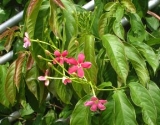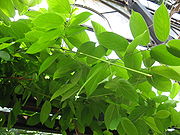
Quisqualis indica
Encyclopedia

Vine
A vine in the narrowest sense is the grapevine , but more generally it can refer to any plant with a growth habit of trailing or scandent, that is to say climbing, stems or runners...
with red flower clusters and is found in Asia
Asia
Asia is the world's largest and most populous continent, located primarily in the eastern and northern hemispheres. It covers 8.7% of the Earth's total surface area and with approximately 3.879 billion people, it hosts 60% of the world's current human population...
. It is found in many other parts of the world either as a cultivated ornamental or run wild. Other names for the plant include Quiscual (in Spanish
Spanish language
Spanish , also known as Castilian , is a Romance language in the Ibero-Romance group that evolved from several languages and dialects in central-northern Iberia around the 9th century and gradually spread with the expansion of the Kingdom of Castile into central and southern Iberia during the...
), Niyog-niyogan (in Filipino
Filipino language
This move has drawn much criticism from other regional groups.In 1987, a new constitution introduced many provisions for the language.Article XIV, Section 6, omits any mention of Tagalog as the basis for Filipino, and states that:...
), Madhu Malti or Madhumalti (in Hindi) and Radha Manoharam (in Telugu
Telugu language
Telugu is a Central Dravidian language primarily spoken in the state of Andhra Pradesh, India, where it is an official language. It is also spoken in the neighbouring states of Chattisgarh, Karnataka, Maharashtra, Orissa and Tamil Nadu...
). The genus translates into Latin for What is that?.
Description
The Rangoon Creeper is a ligneous vine that can reach from 2.5 meters to up to 8 meters. The leaves are elliptical with an acuminate tip and a rounded base. They grow from 7 to 15 centimeters and their arrangement is opposite. The flowers are fragrant and tubular and their color varies from white to pink to red. The 30 to 35 mm long fruit is ellipsoidal and has five prominent wings. The fruit tastes like almonds when mature. The niyog-niyogan is usually dispersed by water.Rangoon Creeper is found in thickets or secondary forest
Secondary forest
A secondary forest is a forest or woodland area which has re-grown after a major disturbance such as fire, insect infestation, timber harvest or windthrow, until a long enough period has passed so that the effects of the disturbance are no longer evident...
s of the Philippines
Philippines
The Philippines , officially known as the Republic of the Philippines , is a country in Southeast Asia in the western Pacific Ocean. To its north across the Luzon Strait lies Taiwan. West across the South China Sea sits Vietnam...
, India
India
India , officially the Republic of India , is a country in South Asia. It is the seventh-largest country by geographical area, the second-most populous country with over 1.2 billion people, and the most populous democracy in the world...
and Malaysia. It has since been cultivated and naturalized in tropical areas.
Uses
The plant is mainly used for traditional medicineTraditional medicine
Traditional medicine comprises unscientific knowledge systems that developed over generations within various societies before the era of modern medicine...
. Decoctions of the root, seed or fruit can be used as antihelmintic to expel parasitic worms or for alleviating diarrhea
Diarrhea
Diarrhea , also spelled diarrhoea, is the condition of having three or more loose or liquid bowel movements per day. It is a common cause of death in developing countries and the second most common cause of infant deaths worldwide. The loss of fluids through diarrhea can cause dehydration and...
. Fruit decoction can also be used for gargling
Gargling
Gargling is the act in which one bubbles a liquid in one's mouth. It usually requires that the head be tilted back, allowing a mouthful of liquid to sit in the upper throat. The head can be tilted by extending either the neck or the back, depending on what is comfortable for the gargler...
. The fruits are also used to combat nephritis
Nephritis
Nephritis is inflammation of the nephrons in the kidneys. The word "nephritis" was imported from Latin, which took it from Greek: νεφρίτιδα. The word comes from the Greek νεφρός - nephro- meaning "of the kidney" and -itis meaning "inflammation"....
. Leaves can be used to relieve pain caused by fever. The roots are used to treat rheumatism
Rheumatism
Rheumatism or rheumatic disorder is a non-specific term for medical problems affecting the joints and connective tissue. The study of, and therapeutic interventions in, such disorders is called rheumatology.-Terminology:...
.
The seeds of this and related species, Q. fructus and Q. chinensis, contain the chemical quisqualic acid
Quisqualic acid
Quisqualic acid is an agonist for both AMPA receptors and group I metabotropic glutamate receptors. It causes excitotoxicity and is used in neuroscience to selectively destroy neurons in the brain or spinal cord...
, which is an agonist
Agonist
An agonist is a chemical that binds to a receptor of a cell and triggers a response by that cell. Agonists often mimic the action of a naturally occurring substance...
for the AMPA receptor
AMPA receptor
The α-amino-3-hydroxy-5-methyl-4-isoxazolepropionic acid receptor is a non-NMDA-type ionotropic transmembrane receptor for glutamate that mediates fast synaptic transmission in the central nervous system . Its name is derived from its ability to be activated by the artificial glutamate analog AMPA...
, a kind of glutamate receptor
Glutamate receptor
Glutamate receptors are synaptic receptors located primarily on the membranes of neuronal cells. Glutamate is one of the 20 amino acids used to assemble proteins and as a result is abundant in many areas of the body, but it also functions as a neurotransmitter and is particularly abundant in the...
in the brain. The chemical is linked to excitotoxicity
Excitotoxicity
Excitotoxicity is the pathological process by which nerve cells are damaged and killed by excessive stimulation by neurotransmitters such as glutamate and similar substances. This occurs when receptors for the excitatory neurotransmitter glutamate such as the NMDA receptor and AMPA receptor are...
(cell death).

